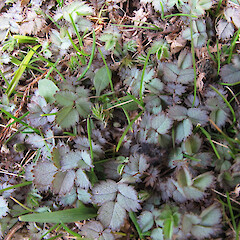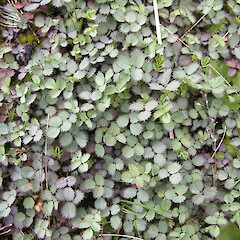Acaena tesca
Common name
bidibid, piripiri
Synonyms
None (described in 1991)
Family
Rosaceae
Flora category
Vascular – Native
Endemic taxon
Yes
Endemic genus
No
Endemic family
No
Structural class
Herbs - Dicotyledons other than Composites
NVS code
The National Vegetation Survey (NVS) Databank is a physical archive and electronic databank containing records of over 94,000 vegetation survey plots - including data from over 19,000 permanent plots. NVS maintains a standard set of species code abbreviations that correspond to standard scientific plant names from the Ngä Tipu o Aotearoa - New Zealand Plants database.
ACATES
Chromosome number
2n = 42
Current conservation status
The conservation status of all known New Zealand vascular plant taxa at the rank of species and below were reassessed in 2017 using the New Zealand Threat Classification System (NZTCS) – more information about this can be found on the NZTCS website. This report includes a statistical summary and brief notes on changes since 2012 and replaces all previous NZTCS lists for vascular plants.
Please note, threat classifications are often suggested by authors when publications fall between NZTCS assessment periods – an interim threat classification status has not been assessed by the NZTCS panel.
- Conservation status of New Zealand indigenous vascular plants, 2017 . 2018. Peter J. de Lange, Jeremy R. Rolfe, John W. Barkla, Shannel P. Courtney, Paul D. Champion, Leon R. Perrie, Sarah M. Beadel, Kerry A. Ford, Ilse Breitwieser, Ines Schönberger, Rowan Hindmarsh-Walls, Peter B. Heenan and Kate Ladley. Department of Conservation. Source: NZTCS and licensed by DOC for reuse under the Creative Commons Attribution 4.0 International licence.
2017 | Not Threatened
Previous conservation statuses
2012 | Not Threatened | Qualifiers: Sp
2009 | At Risk – Naturally Uncommon
2004 | Range Restricted
Distribution
Endemic. New Zealand: South Island (Central Otago and northern Southland - Crown, Pisa, Dunstan, Ida, Old Woman, and Old Man Ranges, Garvie and Umbrella Mountains)
Habitat
Subalpine to alpine. In Chionochloa Zotov tussock grassland, around rock outcrops and between tussocks; also in induced Poa colensoi Hook.f. herbfield; herbfield close to seepages, and in fellfield.
Wetland plant indicator status rating
Information derived from the revised national wetland plant list prepared to assist councils in delineating and monitoring wetlands (Clarkson et al., 2021 Manaaki Whenua – Landcare Research Contract Report LC3975 for Hawke’s Bay Regional Council). The national plant list categorises plants by the extent to which they are found in wetlands and not ‘drylands’. The indicator status ratings are OBL (obligate wetland), FACW (facultative wetland), FAC (facultative), FACU (facultative upland), and UPL (obligate upland). If you have suggestions for the Wetland Indicator Status Rating, please contact: [Enable JavaScript to view protected content]
FAC: Facultative
Commonly occurs as either a hydrophyte or non-hydrophyte (non-wetlands).
Detailed description
Low-growing or mat-forming suffruticose perennial, with dark brown subterranean stems up to 2.5 mm diameter. Long shoots prostrate, rooting at nodes, c.10 cm long with internodes c.10 mm long; short shoots erect, c.20 mm long, c.1 mm diameter, pale brown, sparsely hairy. Leaves imbricate on short shoots, imparipinnate, 10-50 × 5-10 mm. Stipules 3-4 mm long, with margins and tips hairy, and free portion c.1 mm long, entire, triangular. Leaflets 3-5 pairs, gradually reduced in size to base of rachis, broad obovate or orbicular in outline, 2.5-5.0 × 2.5-4.0 mm, truncate at apex or slightly emarginate; upper surface glaucous, with sparse to moderately dense appressed hairs, and indistinct veins; lower surface glaucous, with appressed hairs on veins; teeth 6-9, dull red with pink hydathode area at tip, weakly penicillate. Hair simple, unicellular, 0.2-0.8 mm long, on stipules, rachis and leaflets. Capitulum terminating short shoot, sessile, subtended by several leafy bracts, 5-8 mm diameter at flowering, 25-35 mm diameter (including spines) at fruiting. Bracteoles on receptacle linear-lanceolate, c.2 mm long, with hairy margins. Florets c. 10, very shortly stipitate. Hypanthium c.1.5 × 1.5 mm, enclosing perigynous ovary, sparsely hairy, with 4 very short spines inserted third-way from apex. Sepals 4, arising from hypanthium rim, free or shortly joined at base, 1.5 mm long, ovate, thickened at tip, hairy below. Petals 0. Stamens 2-3; filaments up to 2.5 mm long; anthers 0.5 × 0.6 mm, white. Styles 2, 2.5 mm long including stigma; stigma white, fimbriate, 1 mm broad, protruding from aperture of hypanthium. Fruit indehiscent; achenes 2, enclosed in the hypanthium; hypanthium turbinate, c.2.5 × 2.0 mm, red-brown, 4-ribbed, sparsely hairy; spines 4, 5-20 mm long, red, softly sparsely hairy, at least when young, with a group of retrorse hairs at tip.
Similar taxa
Allied to A. buchananii Hook. F. which differs from A. tesca by its lower altitudinal range, more compact growth habit, densely tufted leafy stems and pale milky green or grey foliage (rather than glaucous). Acaena buchananii has 5-6 imbricate cf. 3-5 pairs of basally remote leaflets, while the capitula of A. buchananii is compressed with spines held erect, rather than the loose ball and divergent spines typical of A. tesca.
Flowering
January
Flower colours
White
Fruiting
February – March (- February)
Propagation technique
Easily grown from fresh seed and from rooted pieces.
Threats
A Naturally Uncommon, sparsely distributed species which is at times locally abundant. There are no known threats.
Etymology
acaena: From the Greek ‘akanthos’ thorn, referring to the spiny calyx that many species have
Attribution
Description adapted from Macmillan (1991).
References and further reading
Macmillan, B.H. 1991: Acaena rorida and Acaena tesca (Rosaceae) - two new species from New Zealand. New Zealand Journal of Botany 29: 131-138.
Thorsen, M. J.; Dickinson, K. J. M.; Seddon, P. J. 2009. Seed dispersal systems in the New Zealand flora. Perspectives in Plant Ecology, Evolution and Systematics 2009 Vol. 11 No. 4 pp. 285-309







